As the year marches on and we head into September I am reminded that this is one of my favourite times of year, the other being May when the blossom appears which now is showing off its Autumn fruits. It doesn’t seem so long since I was gathering the wild leaves and elderflower blossom of Spring, now those elder heads are bowing down heavy with their dark berries and the leaves are starting to tinge with brown and gold.

The first signs of green in our hedgerows are the hawthorn, the brambles and elder, now moving into September they are the first to fade and slowly fall whilst they give us an eye-catching display of rich red crimson and black berries. We go from blossom to fruit as nature gives up her harvest. There seem to have been an abundance of fruits and berries this year, the blackberries have remained firm with the dry weather, I have noticed so many crab apple trees full of fruit, lots of sloe berries, rosehips and the occasional plum and damson tree by the towpath. There will be a good batch of Sloe and Hawthorn Gin this Christmas.
I am also reminded that this is the time of year for stocking up on winter fuel as I gather kindling and notice the swallows stocking up also as they swoop down to the water feeding before they are off on that long journey to their winter sun destination.
After gathering my fruits and being given courgettes, tomatoes, apples and pears from visiting family I can share some of my recipes with you which I hope you enjoy. If you pass me on my travels on narrowboat “Wilderness” give me a shout and hopefully I can pass you a jar of something tasty or a sweet treat!
APPLE CRACKLE CAKE

225 g self raising flour
Pinch of salt
1 tsp ground cinnamon
½ tsp ground nutmeg
100g butter or margarine
100g castor sugar
225g cooking apples
2 eggs
6 tbsp milk
For the topping: 2 tbsp caster sugar and 15g butter or margarine
Sift all the dry ingredients into a bowl, rub in the fat, then stir in the sugar and very finely sliced apples. Mix to a thick batter with the eggs and milk and stir until smooth. Turn into a well-greased and lined 7-8 inch cake tin and give it a gentle bang on the worktop to settle the mixture. Then cover the top with the sugar and small pieces of butter. Bake in the centre of the oven at about 190, gas mark 5 for 40 minutes, then reduce the heat to 160, gas 3 and bake for a further 30 minutes. Turn onto a plate and serve with a dollop of cream or custard, or enjoy on its own with a cuppa.
To use the oven economically, pop a casserole in the bottom for slow cooking at the same time.
BUTTERNUT SQUASH
I roasted a butternut squash by cutting into quarters longways and across to remove the seeds and sinew parts. Once you have your squash skin side down on an oiled baking tray you can add the flavouring whether it be herbs, spices or just salt and pepper. I placed a whole garlic bulb in each of the two parts where I had removed the seeds, a generous drizzle of olive oil all over the top, some garlic salt, dried sage and thyme, ground cumin, ground coriander and a pinch of paprika. Cover with foil and slow roast for about 45 mins in the hot oven. Once cooled the squash can be chopped into large chunks and kept wrapped in foil in the fridge then added to lentils, curries, with feta or blue cheese in a salad or blitzed into a warming soup.
For the last ten minutes while the oven was still on for the Apple Crackle Cake I made a quick batch of easy oat cookies.
OAT COOKIES
Use a large bowl and add 175g self raising flour, 175g sugar, 75g porridge oats, 1 tsp bicarb of soda and 1 tsp baking powder.
In a small pan melt 175g butter with 2 tbsp golden syrup over a low heat, pour this into the dry ingredients and combine into a dough using your hand to firm together. Turn out onto the worktop, flatten out into a long rectangular shape and cut into 28 pieces, then roll each piece into a ball and place onto greased or lined baking trays, you’ll need at least two trays. Flatten out into a disc shape, leaving plenty of room between each one. Bake for 12 to 15 minutes until golden and slightly firm.
Add a tbsp of ground ginger or tsp cinnamon to the dry ingredients if you like.

BLACKBERRY AND APPLE JAM
750g apples (peeled and cored weight)
750g blackberries
½ pint water
1 ½ kg sugar (jam sugar containing pectin is available in larger supermarkets but not essential as the fruit contains natural pectin)
Prepare the fruit and simmer gently with the water until soft, I think the longer the better. Add the sugar and cook rapidly until setting point is reached. To test for setting point drop some of the fruit mixture onto a cool plate and if you can run your finger through it and wrinkles form it is ready, if it runs back then it needs longer.
Make sure your jars have been sterilised in boiling water and are warm when you pour the jam in, pop a seal on top using greaseproof paper cut to fit and pop the tops on straight after.
CRAB APPLE AND CHILLI CHUTNEY
Add the following ingredients to 700g peeled, cored and finely chopped crab apples in a large pan:
230g brown sugar, 1 large finely chopped onion, 1 -3 (depending on heat) finely chopped chillies, ¾ inch piece finely chopped or grated ginger, 2 tsp turmeric, ½ pint cider vinegar and a pinch of salt.
Simmer gently for at least an hour until the consistency is thick and most of the liquid has evaporated. Pour into sterilised jars and seal.
You can follow this recipe using courgettes instead of crab apples, finely chop the courgettes then sprinkle with salt and wrap in a tea towel to drain the moisture for 1 to 2 hours, rinse, drain and dry. Add a pinch of mustard seeds with ground coriander and cumin for an extra kick.
SPICED APPLE CHUTNEY
 5 lb apples (peeled and cored weight)
5 lb apples (peeled and cored weight)
1 tbsp salt
1 small tbsp ground ginger
4/6 chillies depending on heat
1 lb Demerara sugar
½ to 1 pint vinegar
8 oz onions minced or very finely chopped
8 oz stoned dates
8 oz sultanas or raisins
Peel, core and chop the apples, put the salt ginger, chopped chillies and sugar into a pan with some of the vinegar. Add the apples and minced onions and bring to the boil. Add the chopped dates and whole raisins or sultanas and simmer until thick and brown, adding more vinegar as required. The apples will create a lot of juice, but the chutney should not be runny, so continue to simmer until the correct consistency is reached. Put into warm sterilised jars, squash down so there are no air pockets and cover well. As it can be quite tedious chopping the dates and onions, I find it easier to pop them in the mini chopper in batches. As with all chutneys they improve with age, so store in a cool dark place when unsealed and then in the fridge once opened. I call mine “Christmas chutney” and give as gifts along with homemade sloe gin, jams and homemade chocolates and truffles.
AUTUMN FRUIT IDEAS

If you have some fruit and not sure what to do with it, a good start is to cook gently in a pan to make a type of compote. Once the fruit is peeled and chopped place in a pan and add a very small amount of water and sugar. I use about a quarter sugar to fruit, this way it isn’t too sweet, you can always add more. Cook slowly and reduce the liquid down. Once cooled it will keep in the fridge and you can use it on your breakfast oats or muesli, as a base for a crumble or cobbler (see recipes below), or on its own topped with yoghurt, nuts, crème fraiche or custard.
To make a pudding, pop it into the bottom of a greased bowl or tin and pour over a basic all in one sponge recipe (4oz each of self raising flour, sugar and butter or margarine with 2 eggs and 1 tsp baking powder), these quantities are for a small pudding and can be microwaved or baked in the oven.
To make mixed fruit syrups (blackberry or elderberry is a favourite) add a little water to your fruit, about half a pint to 3lb. Cook gently simmering for about an hour, crushing the fruit with a potato masher at intervals. Drain over a sieve lined with thin kitchen roll overnight then add about 10 oz sugar to each pint of juice and stir until dissolved, you can use honey instead of sugar.
I find jams and chutneys so rewarding to make, remember to save plenty of jars earlier in the year!
Jam recipes are mostly on a 1 to 1 ratio jam to fruit, I prefer to use a little less sugar 1 to 0.8.
Fruit chutneys are 100 ml vinegar to every 300g fruit and 100g sugar. Everything goes into one pan and simmer until reduces to very little liquid adding any extras such as nuts, raisins, sultanas, allspice.
ELDERBERRY SYRUP
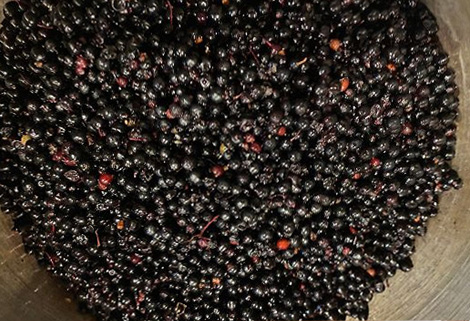
This is a natural medicinal drink to warn off the winter chills, it helps strengthen the immune system and is full of antioxidents. Take one teaspoon daily for the benefits.
Use 8 cups of elderberries* with 1 cup of water and very slowly simmer, add 2 heaped tbsp of grated fresh root ginger, 1 heaped tsp ground cinnamon, ½ tsp cloves, three whole star anise if you have them.
Simmer for about half an hour to 45 mins, crush the berries with a potato masher and then sieve through a fine sieve, return to the pan and reduce the liquid slightly. Sieve for a final time then while still warm stir in about 2 ½ cups honey to sweeten, if you don’t have honey you could use sugar. Bottle into airtight sterilised bottles or jars to store.
*Remove the berries from the stems using a fork, avoid using stems they can be toxic
QUICK OATY FRUIT CRUMBLE
Use the cooked fruit as your base and add a few drops of vanilla essence. Top with a mixture of 50g plain flour with 50g butter rubbed in until resembles breadcrumbs, 100g oats, 50g sugar (I like to use dark or golden caster for better colour), add half a teaspoon of cinnamon or mixed spice if you like and a generous handful of nuts such as walnuts or hazelnuts. Cook in a moderately hot oven for about half an hour.
FRUIT COBBLER
These quantities make a large dish, you can use a large cast iron casserole dish or may prefer to divide between two smaller dishes.
Use homemade compote (see above) or stew any fruit of your choice by using 100g each of butter and sugar with 800g of chopped fruit (I mixed apples and blackberries, plums work well too), add 1 tsp each of vanilla essence and ground cinnamon. It’s not too important to weigh and measure the fruit as long you have a generous base layer to the dish'
For the cobbler topping whisk 1 egg into 100ml milk, in a separate bowl rub 140g butter into 280g plain flour, then stir in 140g sugar, ½ tsp cinnamon, 1tbsp baking powder and a large pinch of salt.
Pour the milk mixture over and bring together to form a thick batter- like consistency.
Tip the stewed fruit, or compote into the dish and top with large spoonfuls of the batter, leaving gaps for the fruit to ooze through. Sprinkle the top with 2 tbsp demerara sugar and bake for 30/35 mins at about 170/gas6 until golden and cooked through.

OVERNIGHT OATS
I love these in the morning, especially when it’s a big day on the move or we have an early start. They are worth making the little effort the night before.
For two servings use one cup measure each of oats and almond milk, you can use any type of milk or just water. Stir in whatever seeds you like such as chia, pumpkin, flax, sunflower etc. I like to add a few walnuts and top with chopped fruit your choice, apples and blackberries work great together, or any stewed fruit and let the juices run through the oats. Cover and place in the fridge overnight and enjoy in the morning. Dried apricots, prunes and figs make a good addition if you don’t have fresh fruit. A drizzle of honey or fruit syrup adds a little more sweetness.

COURGETTES AND TOMATOES
These two seem to go hand in hand and I have made chutney, quiches, fritters, pasta and stir fry dishes with these over the last few weeks. A useful tip when using courgettes, whether you grate them or slice them is to wrap them in a tea towel for half an hour or so to draw out the moisture before cooking.
COURGETTE, PEPPERS, FRESH TOMATOES HERBS AND FETA
Slice 1 ½ courgettes and grate ½ courgette, wrap in a kitchen towel or a t towel to squeeze the moisture out before frying, cut red, green and yellow peppers into strips, and slice a red onion.
Fry gently all together in oil with garlic, plenty of black pepper and a pinch of salt. Add dash of red wine and balsamic glaze.
It’s the fresh tomatoes and herbs which help give that Mediterranean taste, blitz these together in a blender with a few garlic cloves or chop finely. I used thyme, marjoram and basil, if you don’t have fresh use dried. Add to the pan. Simmer gently for about 5 – 10 mins, take off the heat and add plenty of feta cheese cut into chunks, gently stir the cheese through and serve immediately over a bowl of fresh pasta finished with fresh basil leaves.
The feta will keep its shape but just melt in your mouth with a forkful of the courgette and pepper and that rich homemade tomato sauce. Just as good with chunky warm bread instead of the pasta.
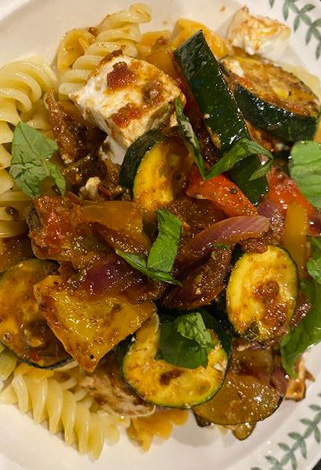

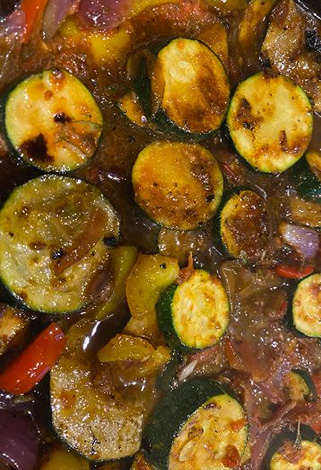
COURGETTE FRITTERS
So easy to make. Grate approx. 300g courgettes and wrap in a t towel to squeeze out the moisture.

Mix together with 100g flour (I prefer self raising as it helps the fritters puff up), 2 eggs, 50g grated cheddar cheese, 50g grated parmesan grated, 50g spring onions chopped, salt and pepper and 1 tsp of mustard seeds or powder. Combine all the ingredients to give a thick batter like consistency.
Heat a large frying pan with a generous amount of olive oil. Add spoonfuls of the mixture to the pan and flatten them slightly to cook evenly, cook for about 3 or 4 minutes on each side until they are golden and crispy. Cook in batches and as you lift them out lay over kitchen roll to drain the excess oil.
They keep in the fridge or freezer and will reheat. Serve with salad and sweet chilli dipping sauce or yoghurt and mint.
You could always substitute the courgette with, sweet potato, lentil, onion etc. or add fish.
As Autumn arrives it’s time for hearty soups and casseroles, one pan meals, pies and comfort food, not to mention curries. There will be lots of these recipes in the next edition. In the meantime, here are a couple of dishes I have recently cooked.
Pork is very underrated, sadly some farming methods are intensive and not the best welfare for the animals, so I shop carefully. When I see my family, I’m lucky to have access to outdoor reared pork products from their “happy pig” farm and I’m proud to say that my Nephew is in the final three for the pig farmer of the year awards later this year!
We have had a lot of enjoyment this Summer from outdoor cooking using our Cobb, but now it’s moving towards darker nights we’ll be back to the indoors, although we enjoyed pork with onions, apple, cider and mustard cooked in the frying pan over the cobb the other night.
SAUSAGE AND LEEK CASSEROLE
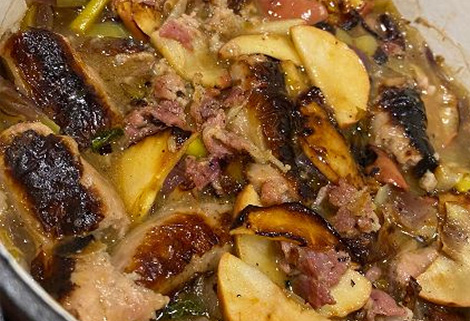 Pork, leek, sage, fennel, apples and cider all marry together with such depth of flavour so here we have an easy casserole using these ingredients.
Pork, leek, sage, fennel, apples and cider all marry together with such depth of flavour so here we have an easy casserole using these ingredients.
8 sausages
4 rashers of streaky bacon cut into small pieces
50g butter
1 or two (depending on size) onions chopped
1 or two (depending on size) leeks chopped
2 garlic cloves crushed
2 tbsp tomato puree
2 tbsp plain flour
300 ml cider
300ml chicken or vegetable stock from a cube
10 fresh sage leaves, keep a few whole and fry in a little oil, chop the rest
1 tsp fennel seeds ground or smashed if you don’t have a pestle and mortar
1 tbsp wholegrain mustard
2 apples, red if possible, unpeeled and sliced into segments
Fry off the sausages in the casserole, turning until browned evenly then set aside, next add the bacon and set aside when just cooked. Drain off some of the oil, leaving about 1 tbsp and add half the butter. Now add the onion, garlic, leek and fennel, gently fry until soft and lightly browned. Sprinkle the flour over and add the tomato puree, stir well to combine, add the cider and stock, stir well and add the cooked sausage and bacon, chopped sage and wholegrain mustard, bring to the boil.
Cover and cook in the oven at about 160/gas 4 for 40 minutes.
When the casserole is ready, melt the remaining butter in a frying pan and fry the apple slices for a few minutes until golden and tender, take care not to overcook so they hold their shape.
Stir the apples into the cooked casserole, sprinkle with the fried whole sage leaves and season with plenty of salt and pepper.
This dish is great served with crusty bread or mashed potato and cabbage.
TRINCHADO BEEF BREDIE
This is a Portuguese influenced dish we first discovered in South Africa, a Bredie is a South African stew and is usually made from mutton. I think there are many variations but here’s one similar to the one we tasted.
1 tbsp butter
1 tbsp olive oil
700g diced beef
Coarse sea salt or malden
1 red pepper cut into strips
1 red and 1 white onion, roughly chopped
1 tsp chilli flakes
1 tbsp sweet chilli sauce
3 cloves garlic, finely chopped
3 tbsp tomato puree
1 bay leaf
10 – 15 (depending on preference) pitted black olives
Juice of 1 lemon
Red kidney beans (1/2 to 1 tin depending on preference)
1 cup red wine
1 cup beef stock
Freshly ground black pepper to taste
1 tbsp flour and 1 tsp dried mixed herbs mixed to a thick paste with a little water
½ cup cream (optional)
Heat the butter and oil together in a casserole dish or heavy based pan, brown the meat in batches and set aside.
Sautee the onions, salt and red pepper in the same oil until the onions soften, add the chilli flakes, chilli sauce, garlic, tomato puree, bay leaf and lemon juice. Cook for a few minutes and then return the meat to the pan along with the olives and beans. Pour in the wine and stock to cover the meat and bring to the boil over a medium heat. Reduce the heat, cover and simmer for an hour on the stove top or in the oven. After an hour, add the pepper and the flour and herb mixture, stir through and return to a moderate oven to thicken. Taste the meat for tenderness and return to the oven if longer cooking is required.
Delicious served with crusty bread or crispy potato wedges cooked in the oven at the same time.

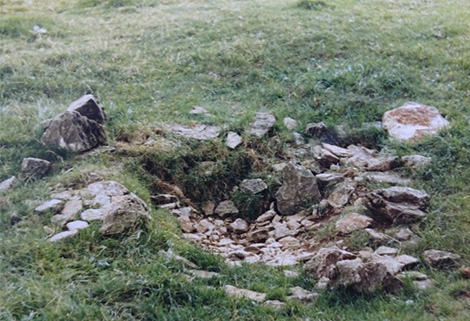

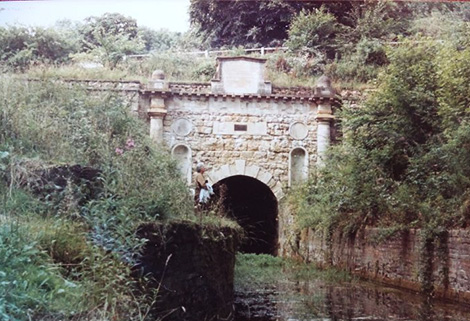

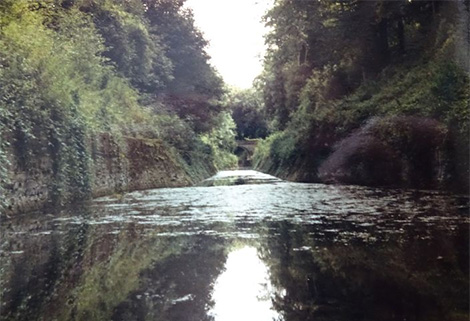




 5 lb apples (peeled and cored weight)
5 lb apples (peeled and cored weight)







 Pork, leek, sage, fennel, apples and cider all marry together with such depth of flavour so here we have an easy casserole using these ingredients.
Pork, leek, sage, fennel, apples and cider all marry together with such depth of flavour so here we have an easy casserole using these ingredients.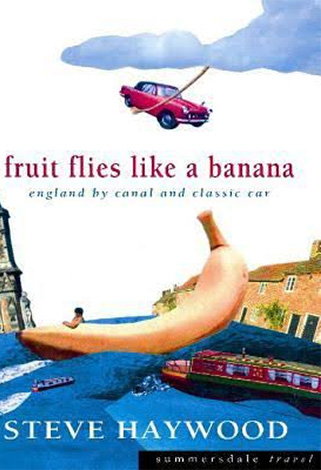



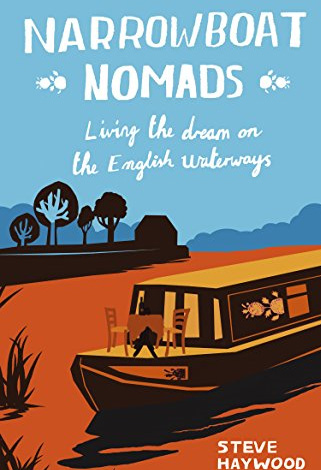
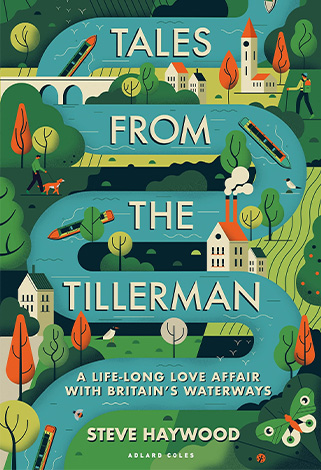
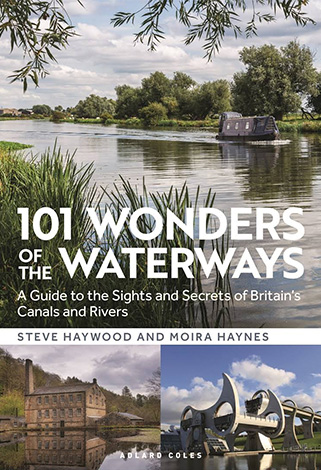
 Steve's books are available from all good bookshops,
Steve's books are available from all good bookshops, 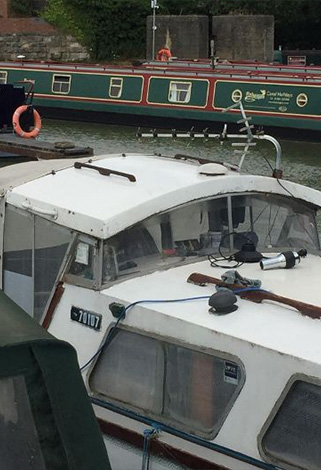 It’s been the same most of my life. However, over the years I developed two skills, how to make any old boat go as fast as it can, often beating far better (certainly better looking) and probably more capable vessels than my own as I learnt one thing about boats – motorbikes anything you wish to power along in a hurry. Lightness is everything, followed closely by a nice smooth passage through the water devoid of sudden jerky movements and over correction. Anticipation is everything.
It’s been the same most of my life. However, over the years I developed two skills, how to make any old boat go as fast as it can, often beating far better (certainly better looking) and probably more capable vessels than my own as I learnt one thing about boats – motorbikes anything you wish to power along in a hurry. Lightness is everything, followed closely by a nice smooth passage through the water devoid of sudden jerky movements and over correction. Anticipation is everything.
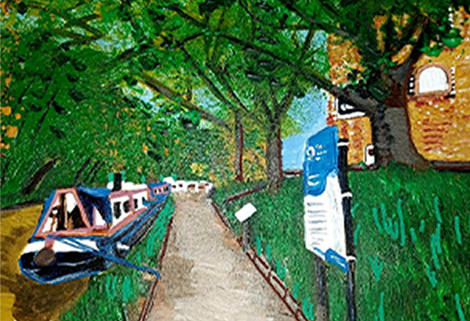






 If you are fitting out a new canal boat or maintaining an existing narrowboat you need to be able to find suppliers who specialise in narrowboat furniture.
If you are fitting out a new canal boat or maintaining an existing narrowboat you need to be able to find suppliers who specialise in narrowboat furniture.